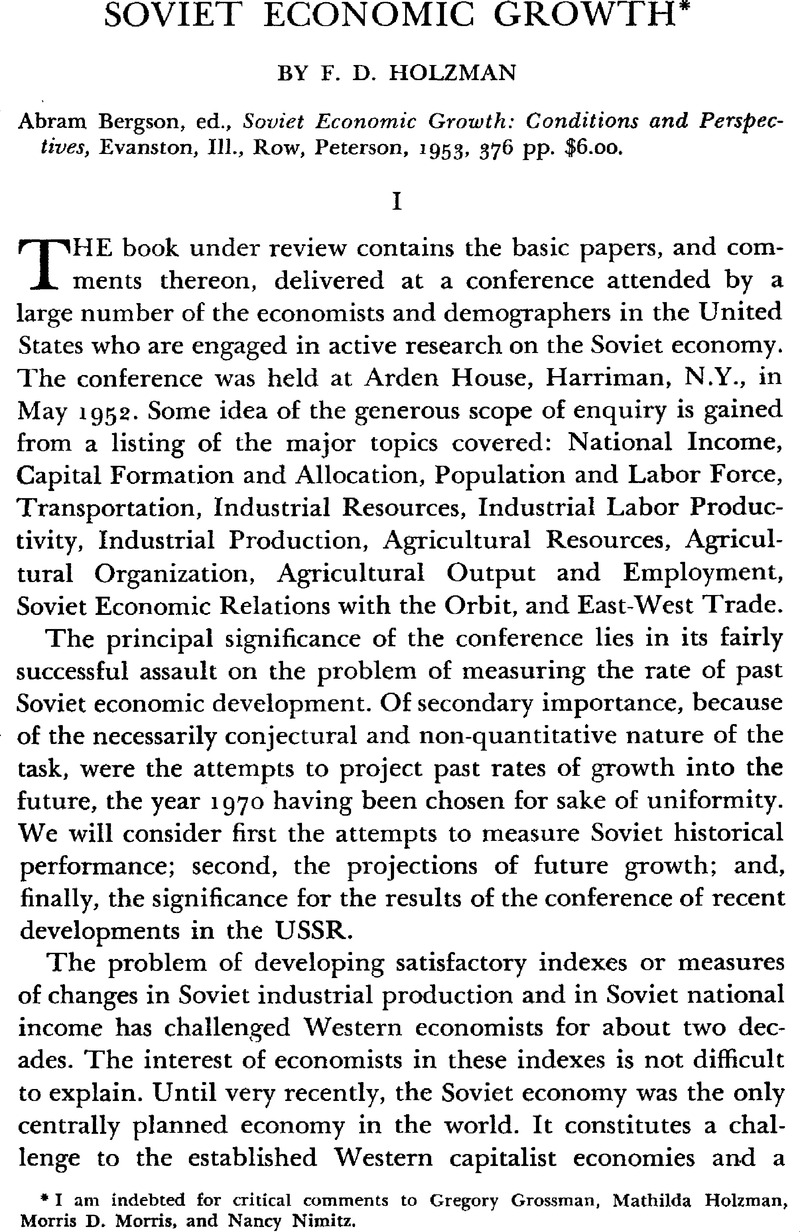No CrossRef data available.
Article contents
Soviet Economic Growth*
Published online by Cambridge University Press: 18 July 2011
Abstract

- Type
- Review Articles
- Information
- Copyright
- Copyright © Trustees of Princeton University 1954
References
1 Alexander Gerschenkron, assisted by Erlich, Alexander, A Dollar Index of Soviet Machinery Output, 1927–28 to 1937, RAND Corporation, 1951.Google Scholar
2 Many Western observers feel that the Soviets would have recomputed their indexes in weights of later years if this had not resulted in a substantial decline in rates of growth already published; such a change would undoubtedly have been difficult to make, for political reasons.
3 Since doubts have been cast on the validity of Jasny's adjustments, Grossman's results must be viewed with some reservations. In this writer's opinion, Jasny's underlying data are probably sufficiently accurate so that Grossman's results establish a correct order of magnitude. (Cf. Jasny, N., The Soviet Economy During the Plan Era, Stanford, Calif., 1951Google Scholar, passim.)
4 The essays of Galenson (Labor Productivity), Eason (Population and Labor Force), Blackman (Transportation), and Harris (Industrial Resources) all shed additional light on Soviet growth trends, but for considerations of space will not be discussed here.
5 As Alexander Erlich points out, however (pp. 92ff.), Kaplan fails to acknowledge the importance for Soviet growth of the rapid increase in industrial labor force.
6 Domar (pp. 87–91) and Millikan (pp. 97–98) question the low Soviet Tate of gross investment adduced by Kaplan from the various essays of Bergson and Heymann. On the basis of independent computations, I would go along with Domar, although I do not feel that the understatement is large for 1937 or 1940, the two prewar years studiedby Bergson and Heymann. More pertinent, however, isthe fact that the rate of investment from 1937 to 1940 was probably somewhat smaller than that from 1929 to 1936 because of large defense expenditures inthe later period, as well as the relatively high level of consumption in the years 1937–38.
7 Leontief, Wassily, and others, Studies in the Structure of the American Economy, New York, 1953, pp. 220–21.Google Scholar
8 Ibid., p. 225.
9 It should be noted that high capital-output ratio industries often possess very durable capital equipment. The short-run disadvantadges of the high capital-output ratio may be offset over the longer period by the advantage of greater durability.
10 These were enunciated in February 1946, with the exception of the electric power goal, which was published in 1951.
11 Discussion of Kershaw's paper, which includes an excellent note by Edward Ames in addition to those by Bergson and Moorstein, was most stimulating. Further light is thrown on the subject by Finegood, I. M., “A Critical Analysis of Some Prevailing Concepts Concerning Soviet Agriculture,” Soviet Studies, IV (July 1952), pp. 15–31CrossRefGoogle Scholar; Nove, A. and Laird, R. D., “A Note on Labour Utilization in the Kolkhoz,” Soviet Studies IV (April 1953), pp. 434–42.CrossRefGoogle Scholar
12 New York Times, March 6, 1954.
13 This should not be taken to imply that the limits of cultivation can be extended much further.
14 If Soviet national income increases in the future at, say, a rate of 5 per cent a year, small increases in the level of personal consumption would, of course, be consistent with mildly expanding military and investment programs.
15 It can be argued that if the peopleare poor, they will work harder to achieve a certain standard of living; or, alternatively, that they will work less hard because the fruits of the laborare so meager. Or if they are rich, they may work less hard because their unsatisfied needs are fewer;or alternatively, they may work harder because the rewards are greater.
16 See Holzman, F. D., Soviet Taxation: The Financial Problems of a Planned Economy (Cambridge, Mass., forthcoming)Google Scholar, ch. 6.
17 The peasant is the residual claimant to the receipts of the collective farm after all costs and exactions of the state have been met. Each individual's share of proceeds depends, therefore, not only upon his own efforts but upon weather conditions, fertility of the kolkhoz plot, and the efforts of his fellow farmers.
18 See Bauer, Raymond A., “The Problem of Political Loyalty,” unpublished seminar paper available at the Russian Research Center, Harvard University.Google Scholar
19 Within the framework of the upper limit hypothesis, this would provide scope for raising the standard of living.
20 Yugoslavia appears to be a case in point.
21 An excellent discussion of the limitations of the power goal to explain the behavior of Soviet leaders is presented by Moore, Barrington Jr, in his new book, Terror and Progress—:USSR, Cambridge, Mass., 1954, pp. 11–13.CrossRefGoogle Scholar




